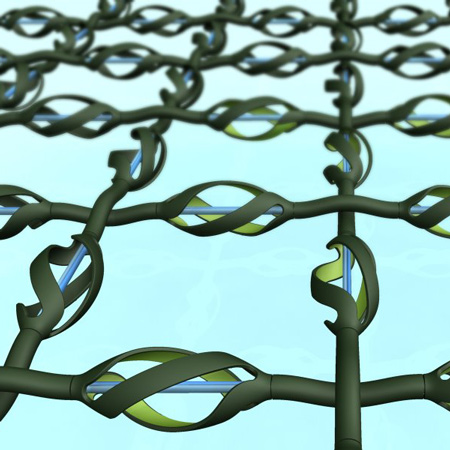Nano Vent-skin is a conceptual project by young designer Agustin Otegu, featuring miniscule bio-turbines that could clad buildings to generate energy and absorb carbon dioxide from the atmosphere.
The project suggests using several kinds of micro organisms to create a material which performs different functions where needed, absorbing and transforming natural energy from the surroundings.
See the project website for more information.
Here's some text from Otegu:
--
Nano Vent-Skin
This project was born after seeing all the gigantic projects being built around the world where it seems that in order to be green you have to think big and build something impressively huge. Why don't we start thinking on a smaller scale and apply it to existing buildings, houses and structures (tunnels, road barriers, etc) to generate energy?
NVS is a set of micro turbines (25mmx10,8mm), which generate energy from wind and sunlight
How does NVS work?
The outer skin of the structure absorbs sunlight through an organic photovoltaic skin and transfers it to the nano-fibers inside the nano-wires which then is sent to storage units at the end of each panel.
Each turbine on the panel generates energy by chemical reactions on each end where it makes contact with the structure. Polarized organisms are responsible for this process on every turbine’s turn. The inner skin of each turbine works as a filter absorbing CO2 from the environment as wind passes through it.
Each panel has four round supply units (one on each corner). These units are in charge of:
- Monitoring that all the turbines are working.
- Delivering material to regenerate broken or malfunctioning turbines.
- Receiving and storing the energy produced by the turbines.
These micro organisms have not been genetically altered; they work as a trained colony where each member has a specific task in this symbiotic process. For example, an ant or a bee colony, where the queen knows what has to be done and distributes the tasks between the members.
Imagine NVS as the human skin. When we suffer a cut, our brain sends signals and resources to this specific region to get it restored as soon as possible. NVS works in the same way. Every panel has a sensor on each corner with a material reservoir. When one of the turbines has a failure or breaks, a signal is sent through the nano-wires to the central system and building material (micro organisms) is sent through the central tube in order to regenerate this area with a self assembly process.
As researchers have stated, nano-manufacturing will be a common way to produce everyday products.
In order to achieve the best outcome of energy, the blades of each turbine are symmetrically designed. With this feature, even if the wind's direction changes, each turbine adapts itself by rotating clockwise or anti-clockwise, depending on the situation.
NVS is not trying to reinvent or reshape nature. It’s just acting as a merger of different means and approaches into energy absorption and transformation, which will never happen in nature. For example: a palm tree can never learn from an arctic raspberry bush or a bonsai tree if they never coexist within the same surroundings.
NVS takes advantage of globalized knowledge of different species and resources and turns them into a joint organism where three different ways of absorbing and transforming energy work in symbiosis. Using nano-manufacturing with bioengineered organisms as a production method, NVS merges different kinds of micro organisms that work together to absorb and transform natural energy from the environment.
What comes out of this merging of living organisms is a skin that transforms two of the most abundant sources of green energy on earth: sunlight and wind. There is another advantage of using living organisms: the absorption of CO2 from the air.

